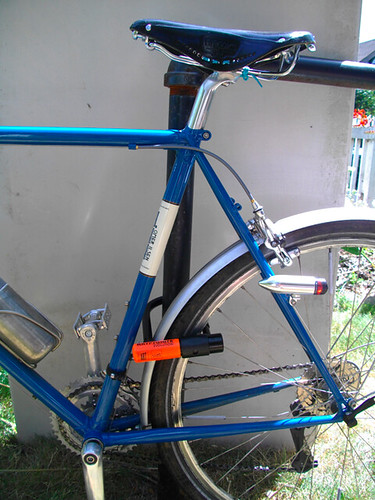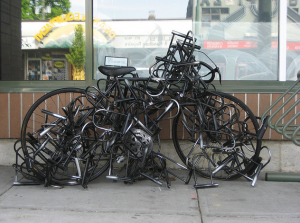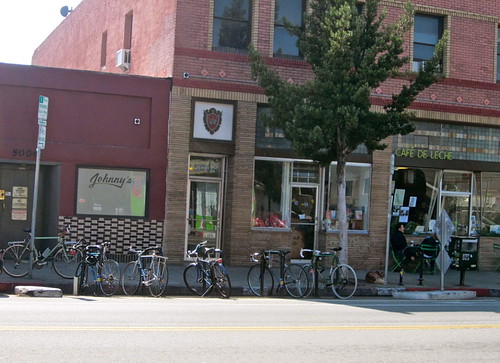What if someone told you there were a way to safely lock your bike with a not a key, but a smartphone app? And that this same app enables you to seamlessly borrow a friend’s bike, effectively allowing users to create their own bike-share network? And that the app alerts you if your bike has been stolen?
That’s the amazing and genius concept behind BitLock, a kickstarter idea that has just reached its crowd-sourced funding goal. The below one and a half minute video manages to easily explain how it works while capturing the incredible uses and benefits the device has the potential to offer the world.
(The world’s coolest bike lock? Could very well be! Video credit: Terry Knight)
For additional details about BitLock, visit its Kickstarter page.
Tag: bike lock
How Do You Lock Up?
(Five bicycles locked to bike racks, one bike rack locked to a sign post. Photo credit: Walk Eagle Rock)
Whether you’re going to your favorite restaurant for lunch or to the local grocery store to pick up a few items, bicycling is a great way to get there– especially as the days are getting longer it’s a perfect time to take advantage of the gorgeous weather to hop on a bike. Of course, once you get to your destination it’s always a good idea to lock your bike properly to a designated bike rack if possible. Even if you’ll “just be a minute,” remember, it takes less time than that to steal an unlocked bike.
So, to help keep you and your bike together, here’s a round-up of helpful bike locking tips and types of locks to consider.
Tips of Locking
Los Angeles’ Department of Transportation Bicycle Blog has a handy three part series about why you should lock your bike, where to lock your bike and how to properly lock your bike. Here’s an excerpt from the series:
Try to park in a location where your bike can be seen. A good rule of thumb is: are other bikes parked there? Bike thieves don’t want to be seen, so park in areas with a lot of pedestrian traffic. The more people around your bike, the better. If you’re parking at night, try to park in a location that provides good, safe lighting. If you can’t find anywhere you’re comfortable with, you can always ask store owners if you can bring in your bike. The worst thing they can say is “no”, and piece of mind is worth the trouble of asking.
The LADOT even offers this concise list of bike parking tips.
The San Francisco Bicycle Coalition has additional details about proper locking technique to ensure your bike doesn’t get stolen.

(The “Sheldon Brown” Lock Technique, note the lock is around the rear wheel inside the rear ‘triangle’ of the frame. Photo credit:Kaptain Amerika)
The ‘Sheldon Brown (RIP)‘ Lock Technique: By locking your back wheel inside the rear triangle, you protect your wheel and the frame. It’s nearly impossible to cut the rim of a wheel. Just make sure your lock is around the rim and through the triangle. Hint: Front wheels are less expensive than back wheels – back wheels have gears and cost about twice as much, so if you can only protect one wheel, make it the back one!
Types of Locks
(The common u-lock and it’s qualities– click for more details. Screen grab via: REI)
Also useful to know are the different kinds of locks to consider for your bike. REI offers simple descriptions and pictures of different kinds of locks and their respective qualities.
Additional Notes
- If there is no bike rack available at your destination, find a sturdy post or object to lock your bike to. If locking to a post, be sure it is tall enough so that a thief can’t simply lift the bike up over the top of the post and walk away with your bike. Also, ask at your destination if they can provide safe bike parking– sometimes business owners aren’t aware of the need and demand for safe, convenient bike parking.
- Never lock your bike with just the front or rear wheel. Whether you have quick release or not, wheels are relatively easy to remove so if you just lock your bike to either front or rear wheel someone could detach the frame from the locked wheel and walk away with your bike frame.
- Related to the above bullet– if you can only lock one portion of your bike, lock your frame. Typically a bike is safe as long as the frame is securely locked. While this leaves your wheels vulnerable there is a smaller market for stolen wheels than for stolen frames.
- Do NOT buy a chain and lock from a hardware store to use as a bike lock. Rarely are chains and locks from hardware stores good for securely parking a bike. Also avoid purchasing bike locks from major retail department stores if possible, the quality of their locks are always inferior to locks available at bike shops.
- A bike lock, no matter how expensive, is still cheaper than buying a new bike. If a bike lock costing $50 or more keeps your bike safe for a life time it’s a worthy investment.
- Don’t forget to check out 511 Contra Costa’s public bike locker map of Contra Costa County
- Find out if your city has a “request a bike rack program.” San Francisco and Oakland both websites with easy instructions that let the public request bike racks where desired. Your city may have one too, especially if your city has an approved bike plan that calls for additional bike parking– try contacting your local officials and find out how you can get convenient and secure bike parking where you need it.
- Lastly, if you want to see comical demonstrations of good and bad locking jobs, check out this video “Hal Ruzal Grades Your Bike Locking”
http://www.youtube.com/watch?v=aTA3JsZWiec
Keep your wheels where you leave them: Bike Locking 101
 Few things are more heartbreaking than coming back to find your bike is missing. It happens to the best of us, but there are extra precautions we can all take to protect our rides.
Few things are more heartbreaking than coming back to find your bike is missing. It happens to the best of us, but there are extra precautions we can all take to protect our rides.
1) Lock both the front wheel and the frame.
Do you have a quick release front wheel? Make sure any piece of your bike that could come off is secured to something. If you’ve ever seen an abandoned bike missing its front wheel, or just an abandoned front wheel – it used to belong to someone that should have locked their wheel and frame together.
2) Inspect the thing you’re locking onto.
Could someone lift the bike over the top of that post? Take a few seconds to think like a thief.

3) Make sure your lock is sturdy.
Avoid cable locks. Every year during undergraduate orientation, we would take the first broken cable lock of the year and use it to show parents what kind of lock *not* to buy their children. Invest in a sturdy U-shaped lock. If you have trouble getting both the frame and front wheel in your U-lock, get a bigger one.
4) Consider your seat.
It’s not as depressing as having your entire bike stolen, but a missing seat will still ruin your day. Tighten your seat and post as much as possible, and consider a seatpost lock.
Fortunately, your local transit agencies are working to keep your bike safe while you’re out and about. Check out these funky (but secure!) bike lids at the Santa Rosa Transit Center.

When you have your bike with you on BART, look for these Bike Spaces. These just make it easier to have a bike – you still need to keep an eye on it. It’s better not to lock your bike while riding the train, too.

Looking for a little fun? Check out this StreetFilm series: Hal and Kerri Grade Your Bike Lock. What would you give your bike locking prowess?
If all else fails and your bike is stolen while you’re at work, don’t forget about Contra Costa County’s Guaranteed Ride Home program!


